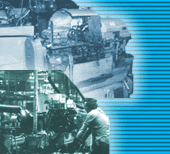Metalworking Fluids
On this Page

Metalworking fluids (MWFs) are used to reduce heat and friction and to remove metal particles in industrial machining and grinding operations. There are numerous formulations, ranging from straight oils (such as petroleum oils) to water-based fluids, which include soluble oils and semisynthetic/synthetic fluids. MWFs may be complex mixtures of oils, emulsifiers, anti-weld agents, corrosion inhibitors, extreme pressure additives, buffers (alkaline reserve), biocides, and other additives. In use, the fluid complexity is compounded by contamination with substances from the manufacturing process (such as tramp oils, hydraulic fluids, and particulate matter from grinding and machining operations). Furthermore, water-based metalworking fluids support microbial growth, which introduces biological contaminants (such as bacterial and fungal cells or cell components and their related biological byproducts such as endotoxins, exotoxins, and mycotoxins). In order to properly estimate the exposure to MWF, the NIOSH criteria document recognizes that extractable MWF aerosol measurements may be useful where there are simultaneous exposures to nontoxic particulate materials and MWF aerosols. However, significant insights into worker exposures have also been demonstrated by separating (by extraction) MWF aerosol from toxic solid aerosols such as welding fume.
Some 1.2 million workers in machine finishing, machine tooling, and other metalworking and metal-forming operations are potentially exposed. Workers can be exposed to the fluids by breathing aerosols generated in the machining process, or through skin contact when they handle parts, tools, and equipment covered with the fluids. The National Institute for Occupational Safety and Health (NIOSH) defines MWF aerosol as the mist and all contaminants in the mist generated during grinding and machining operations involving products from metal and metal substitutes.
Occupational exposures to metalworking fluids may cause a variety of health effects. Respiratory conditions include hypersensitivity pneumonitis (HP), chronic bronchitis, impaired lung function, and asthma. Work-related asthma (WRA) is one of today’s most prevalent occupational disorders, imposing significant costs in healthcare and workers’ compensation. Dermatologic exposures are most commonly associated with, but not limited to, allergic and irritant dermatitis (skin rash). In addition, substantial evidence shows that past exposures to some metalworking fluids were associated with increased risk of some types of cancer. Although actions taken in the last several decades have reduced that risk, it is not known if these actions have totally eliminated the risk.
NIOSH recommends that exposures to MWF aerosols be limited to 0.4 milligrams per cubic meter of air (thoracic particulate mass) or 0.5 milligrams per cubic meter of air (total particulate mass), as a time-weighted average concentration up to 10 hours per day during a 40-hour workweek. The recommended exposure limit (REL) is intended to prevent or greatly reduce respiratory disorders associated with MWF exposure. Some workers have developed WRA, HP, or other adverse respiratory effects when exposed to MWFs at lower concentrations. This REL is technologically feasible for most metalworking operations.
NIOSH NMAM method 5524 [PDF - 217 KB]
NIOSH-specified technioque for estimating doses due to inhilation of MWFs.
NIOSH Method 5524 requires that MWF aerosol be separated from co-sampled solid particulate using an extraction funnel. Such funnels were commercially available until recently discontinued by the manufacturer. A replacement funnel was designed by the author of the method and is now commercially available from a specialty laboratory equipment supplier.
Several preventive measures are available to reduce MWF exposures and their effects. Formulations have been developed with safer, less irritating additives and MWF components. Machinery has been modified to limit the dispersal of MWF mists. In addition, the use of protective gloves, aprons, and clothing, the education of workers regarding the safe handling of MWFs, and the importance of workplace personal hygiene are all key to controlling the exposures to MWFs.
NIOSHTIC-2 Search
NIOSHTIC 2 search results on Metalworking Fluids
NIOSHTIC-2
is a searchable bibliographic database of occupational safety and health publications, documents, grant reports, and journal articles supported in whole or in part by NIOSH.
NIOSH Resources
What You Need to Know About Occupational Exposure to Metalworking Fluids [PDF - 238 KB]
DHHS (NIOSH) Pub. No. 98-116 (1998)
This document contains a critical review of the scientific and technical information available on the extent and type of health hazards associated with metalworking fluids and the adequacy of control methods.
Criteria for a Recommended Standard: Occupational Exposure to Metalworking Fluids
DHHS (NIOSH) Pub. No. No. 98-102 (1998)
This criteria document reviews available information about the adverse health effects associated with occupational exposure to metalworking fluids (MWF's) and aerosols.
Other Resources
Metalworking Fluids: Safety and Health Best Practices Manual
This OSHA document was developed by the OSHA Metalworking Fluids Standards Advisory Committee.
OSHA Safety and Health Topics: Metalworking Fluids
Useful summary with extensive links to information about hazard recognition, exposure evaluation and control, and applicable compliance standards.
Prevention Of Skin Problems When Working With Metal Working Fluids [PDF - 12.6 KB]
An educational brochure prepared by the Washington State Department of Labor and Industries. Report 55-7-2001 (2001).
Shop Guide to Reduce the Waste of Metalworking Fluids: A Competitive Advantage Manual for the Metal Fabricating and Machining Industry [PDF - 734 KB]
Prepared by the Institute of Advanced Manufacturing Sciences and the Waste Reduction and Technology Transfer Foundation.
Management of the Metal Removal Environment, 2nd ed
A free, web-based guide to management and control techniques for the metalworking fluid environment, prepared by Organization Resources Counselors, Inc.
E1497-00 Standard Practice for Safe Use of Water-Miscible Metal Removal Fluids
ASTM standard practice that covers product selection, storage, dispensing, and maintenance.
- Page last reviewed: August 16, 2013
- Page last updated: August 16, 2013
- Content source:
- National Institute for Occupational Safety and Health Division of Applied Research and Technology


 ShareCompartir
ShareCompartir